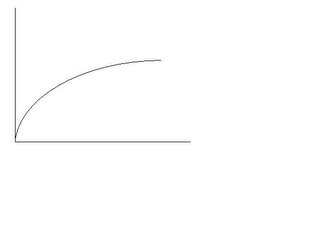Democratic Peace and Happiness
Dr. Rummel has again presented some interesting findings about freedoms and happiness.
The above link goes to his full text that is first analyzed by worldvaluessurvey.org.
That out of the way, the author's show that subjective well being is highly correlated with economic development (.70) as measured by GNP. No surprise there. But, they point out:This process is not linear, however. The correlation weakens as one moves up the economic scale. Above $13,000 in 1995 purchasing power parity, there is no significant linkage between wealth and subjective wellbeing. The transition from a subsistence economy to moderate economic security has a large impact on happiness and life satisfaction, but above the level of Portugal or Spain, economic growth no longer makes a difference.
This correlates with the microeconomic theory of diminishing marginal utility. As people get more of any good he/she receives less utility (happiness) per unit consumed. Below I tried to graph a marginal utility derived from income on the horizontal axis and utility on the vertical axis.

This shows that at low income levels an increase in income increases hapiness more than the percentage change in income. The slope is above unity(slope>1). But as income goes up utility has less effect on the total happiness as the slope of the curve becomes closer to zero. I assume that income is a positive good and the marginal utility never becomes negative since money can be fungible and used to purchase other goods.
From the above information it appears that $13,000 PPP is where the marginal utility of income becomes close to zero with no more significant effect on a persons happiness. This then leads to what other factors can increase or decrease a nations overall happiness. Anyone up for a social utility curve?
This chart is shows the correlation between well being and freedoms:
And RJR comment:
The correlation between well-being and freedom (liberal democracies, in effect) is .78. This is liner. The curvilinear (polynomial or logged correlation would be higher, since it would account for the slight sag in the middle of the distribution) of a number of partially free nations, some being electoral democracies such as Mexico and Turkey. Although the plot seems to imply that freedom is the cause of well-being (it can't be the other way around), the author's believe that this is in question, and that other factors may better account for well-being.
While Dr. Rummel does not show the correlation between income and freedom, I still wanted to show a utility curve with a "dip" in the center:

Although this is my theory, I can see this effect happening to people that is in the middle ground. They are not destitute so the level of utility is high but can see the promised land and thus are not completely satisfied (marginal utility stagnant in this income band) in there present location. Just as some nations are partially free but are not completely satisfied since they have seen how other countries have freedoms. RJR uses the examples of Mexico and Turkey that are close allies with the US and of course Mexico knows more about the US than we know about them.
Addition 11-19-2005:
For world wide policies implications, this should lead us to try and bring the most number of people to $13,000PPP in the world. I am not suggesting that we redistribute income, but that this is the target for achieving the most happiness for the most number of people worldwide. While I think that we should tax at all income levels (low marginal taxes), we at least know the portion that will not affect happiness (utility) as much as below this mark. The reason for some taxes is that that person has a sense of contribution to society as a whole. That nothing is a free ride in life.
And of course the best way to insure the well being of more people is with democratic peace.


0 Comments:
Post a Comment
<< Home